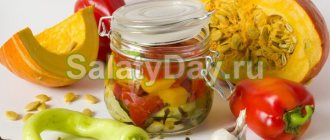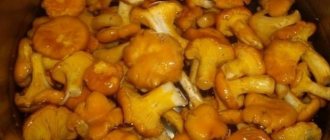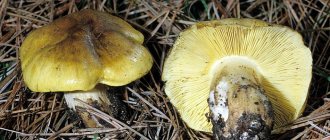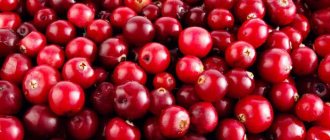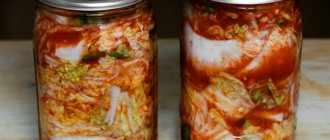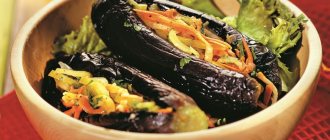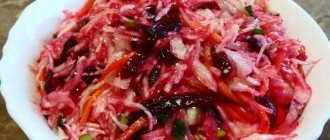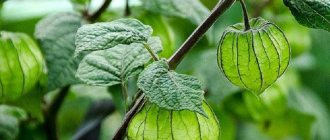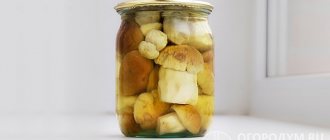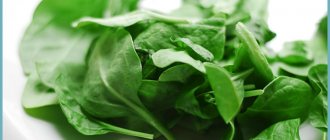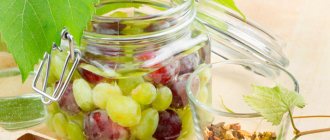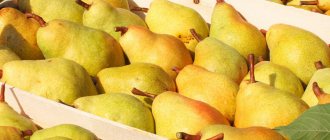Leeks are used in appetizers, salads, soups, side dishes and baked goods. This vegetable contains vitamins A, B, PP, E, H, minerals (calcium, magnesium, sodium, phosphorus, iron), and ascorbic acid, the amount of which does not decrease, but increases during storage.
When properly stored, leeks retain their beneficial properties and taste for a long time. To keep it fresh for as long as possible, you must follow the rules for storing and preparing onions for the winter.
Leeks are a source of vitamins all year round
Since the times of Rus', people have given great preference to onions, adding them to many dishes. At that time, they did not yet have knowledge about all the benefits of this vegetable, but they noticed that it had certain healing properties. Today, the beneficial properties of onions have been studied by science.
The main advantage can be considered the phytoncides included in its composition, which have an antimicrobial effect. That is why in folk medicine, leeks are considered to be the main weapon in the fight against colds. It contains the following vitamins: B1, B2, B3, C, E, PP, provitamin A.
The vegetable has antitumor, diaphoretic, diuretic, hemostatic, wound-healing and anti-inflammatory effects - the benefits for the body are simply enormous!
In addition, onions are credited with properties that improve the functioning of the gallbladder and intestines. In addition to the listed vitamins, it contains mineral salts, organic acids and essential oils. There are about 300 species of this amazingly healthy vegetable in the world. In the kitchen, it is given the most important role; it is used in soups and side dishes, salads and gravies, sauces and seasonings, and canning.
Several preparation features
Leeks are unpretentious and almost always produce a good harvest, but few know how to keep them fresh for a long period. It should be specially prepared for long-term storage, taking into account the following features:
- the harvest is harvested around the end of September or beginning of October;
- slight frosts are not dangerous for leeks, but it is advisable to collect them before the first frost;
- during the collection process, the bulbs must be carefully dug out and not pulled out;
- after harvesting, the roots must be trimmed without damaging the bottom of the bulbs;
- feathers can be harvested throughout the growth period.
To ensure storage of leeks throughout the winter, they are cut into small pieces (rings or strips) and frozen. Also, chopped onion rings can be dried in the oven and later used as seasonings.
Attention! After freezing, leeks do not lose their taste and medicinal qualities. It is better to freeze it in small portions.
Leeks - proper storage and preparation for the winter
If in the summer we can take leeks directly from the garden, then for the winter we should think about harvesting them. To do this, it is recommended to pickle or preserve it. To pickle this vegetable, you will need: 1 liter of water, 100 g of sugar and 50 g of salt, 100 ml of vinegar and the onion itself.
When marinating, use the white part of the onion and rinse it well under running water. Then blanch the vegetable for 1 minute in boiling water. Next, we put it in sterilized jars, and bring the water (in which we blanched) to a boil and add salt, sugar and vinegar to it. Calculate the amount of liquid so that it is enough to fill the glass containers up to the shoulders. Cook the marinade for about 3 minutes and pour it into jars. We roll up the container and turn it upside down.
Canned leeks are an excellent preparation for the winter. For it you need: 250 ml of water, 150 g of honey, 100 ml of vinegar, bay leaf, 2 chili peppers, 1 tsp. salt and 2 kg of onion. Some gourmets also add juniper (6-7 berries). The leek is washed with water and cut into pieces. The marinade is cooked for about 5 minutes after boiling. The onions are placed in a wide container and filled with the resulting brine. The container is covered with a thick cloth or towel and left at normal temperature overnight, after which it is boiled again and filled into sterile sealing jars.
Where and in what to store
For the winter, leeks are prepared fresh, dried, frozen and canned.
Fresh vegetables are stored in the cellar, basement, refrigerator, on the balcony, using methods of laying in sand and trenches.
In the cellar/basement
Often a cellar or basement is chosen to store leeks, which can accommodate a large amount of product.
Only large plants are selected for planting. The roots are cut by 2/3, the leaves are left uncut or cut by 1/3.
Important! Unpruned leaves will turn at least half yellow during storage. They cannot be cut off completely, as they feed the false bulb.
Place the leeks in a vertical position in a container with a lattice bottom and place it on a shelf.
When stored indoors, maintain temperature conditions. At temperatures above +1°C, the onions will begin to rot. To preserve it for a long time, the room is ventilated 2 times a month.
In a refrigerator
The most beautiful and healthy vegetables are selected for storage in the refrigerator. The onions are washed and dried. Place in bags of 5-7 stems or pack in cling film. To allow the vegetable to breathe, small holes are made in the film and bags.
On the balcony
This option is used in regions with a mild climate, since leek can withstand temperatures down to –7°C. Plants are laid out in boxes in one layer, covered on top with insulating material that allows air to pass through. Vegetables are periodically inspected. Damaged plants are removed to ensure the safety of others.
In a ditch/trench
To store leeks in a greenhouse, dig a shallow trench. Onions are placed vertically in it and sprinkled with sand to a depth of about 5 cm. In winter, it is important to ensure that the temperature in the greenhouse does not drop below +1°C.
In sand
Sand is poured into a box or container in a layer of at least 5 cm, which should be slightly moistened. Leeks are inserted into the sand so that there is a distance of 2-3 cm between the plants. The free space between the vegetables is sprinkled with sand. The filled container is placed in a cool, dark place for storage - in a cellar or basement.
How to store leeks in winter - for apartments and private houses
Storing vegetables in an apartment is always a problem. Many housewives at least partially solve this problem with the help of a freezer. If you cut leeks into pieces and pack them in plastic bags, they won't take up too much space in the freezer. You can divide it into several bags to make it easier to take out. The important thing is that all the vitamins and microelements present in it do not completely disappear when frozen, as is often the case with other fruits and vegetables. By the way, you can store carrots in the same way, after grating them.
Preparing a green vegetable
Fresh greens tend to spoil quickly. To preserve nutrients, you need to stock up on vitamins during the season. Before storing leeks, they must be properly prepared.
Important : before freezing, the onions must be completely dry, otherwise the cooling or drying process will be ruined. For these purposes, it is better to use a waffle towel; it absorbs moisture more effectively.
Follow these instructions:
- Rinse each stem separately under running water. Pay special attention to the place where the leaves meet. Mostly, dirt and soil accumulate there and must be removed with special care.
- Spread the plant evenly on a clean waffle towel. Leave in this position until completely dry. This will take approximately 1.5-2 hours.
Selecting and preparing leeks for pickling
Leeks are a woody green vegetable with a mild onion flavor. It is consumed raw, stewed, and pickled.
The appearance of the product is the main criterion for assessing quality. On supermarket shelves it is wrapped in polyethylene, so it is almost impossible to smell it, but it is not difficult to detect damage through the transparent packaging.
What an ideal leek looks like:
- absence of spots and contrasting shades on it;
- the root is light and pure (the lighter the color, the richer the taste);
- the length of the white part is no more than 6 cm, this is the quality standard;
- stem diameter - not less than 1.5 cm;
- the surface should not be too dull or shiny;
- growths and compactions on the stems are unacceptable;
- the leg of the “correct” leek is cylindrical, the base is in the shape of an onion - a sign of a low-quality product;
- The onions should not be sticky, wet or slippery.
It is not difficult to prepare the product for further culinary processing. It has no husks, so cleaning takes minimal time.
The main task is to wash it well with running water and cut off the green part, which is usually not used for food. However, instead of throwing away the green feathers, you can freeze them and then add them to broths and soups for flavor.
The root is cut 4-5 cm from the edge. The white part suitable for consumption is cut in half lengthwise and washed again with running water, trying to remove sand between the plates.
Large leeks are cut into 4 parts, small ones - into 2 halves. Cutting into rings is also possible.
To prepare the marinade, use a variety of spices and herbs, vegetable oil, lemon juice, table or wine vinegar. The prepared onions are poured with hot liquid directly into the jars.
Reference. Leeks are sold year-round, but taste best from September to the end of April.
Harvest
Every gardener knows when to harvest leeks. The growing season of leeks is long, so experts advise removing them just before frost. When to dig up leeks, the gardener decides for himself; it can be the end of August or mid-September. The crop is not afraid of frost, so until this time it can feel comfortable in the garden. If you want to enjoy a juicy, tender vegetable in early spring, you can leave a small amount of the plant in the garden during the winter. To prevent pearl onions from freezing, you need to cover them with covering material.
Onions can be eaten until the coldest weather
, and even frost does not affect the nutritional quality of its feathers. Until frost, onion feathers are able to remain juicy and soft.
To grow a crop planned for winter storage, you need to give it a personal bed. You cannot pick onion feathers in this bed during the summer.
Harvesting must be done carefully, digging up each root crop so as not to damage the bulb. In addition, when digging up a leek, you need to make sure that lumps of soil do not get between the feathers. When the crop is dug up, it is necessary to select the strongest specimens for storage. The bulbs must not have any flaws. If you leave spoiled or injured bulbs in storage, there is a risk of losing the harvest completely.
The selected bulbs must be cleaned of any remaining soil. This should only be done with your hands. Under no circumstances should you hit them against each other. Otherwise, they will be damaged and will not be suitable for storage. After cleaning, trim the onion to a length of 25 cm and leave the prepared product to dry in the sun until completely dry. After which you can begin to prepare it for storage.
Few people know that leek not only retains its beneficial composition during storage, but also accumulates ascorbic acid. Thus, with proper storage, the plant is enriched with an even greater composition of vitamins.
The vegetable can be eaten from the very beginning of its ripening. It has pleasant-tasting and very tender leaves. It is recommended to use them either fresh on their own or added to any dishes, salted, dried and frozen.
To have fresh vegetables on the table throughout the winter season, you must follow simple storage rules:
- Only whole plants can be stored. They must not be damaged.
- All plants intended for long-term storage must have strong and intact bottoms.
- Only one type of plant should be stored in one container.
- Leeks should be sent for storage cleaned of any remaining soil and well dried in the sun.
There are several ways to store leeks at home.
It is very important for long-term preservation to create conditions close to optimal. Onions are not at all afraid of frost, but the temperature must be maintained no higher than +5 degrees. The root crop is very sensitive to air humidity.
If the humidity is high, the crop will not be stored for long. Therefore, the optimal humidity during storage should be 85%. Ventilation is also a necessary condition for storage.
By following all storage rules, long-term storage can be achieved.
Shelf life:
- the vegetable can be stored in the refrigerator for up to 4 weeks;
- in a box with sand, the root crop can be stored until spring;
- dried, pickled or salted onions can be stored for up to 1 year.
If you comply with 3 simple requirements, namely humidity, ventilation and a suitable temperature, preserving the harvest will not be difficult.
To avoid serious mistakes during storage, you should listen to the advice of experienced gardeners:
- It is undesirable to store root vegetables of different varieties in one container;
- effective storage is possible only in ventilated sealed containers;
- spoiled plants must be removed on time;
- choose varieties suitable for these purposes for storage.
Should know
, that early-ripening and mid-ripening varieties are not intended for storage.
How to pickle leeks
Leek is a unique vegetable that attracts with its versatility. When fresh, it can enrich the taste of meat, fish and vegetable dishes. Marinating in vinegar will help preserve the maximum of useful components. Minor heat treatment removes bitterness, preserving taste and vitamins. We suggest adopting a classic quick recipe for preparing a savory snack.
Ingredients:
- leeks - 5 pcs.;
- sugar - 50 g;
- rock salt - 12 g;
- vinegar 6% - 3 tbsp. l.;
- water - 0.5 l;
- bay leaf - 2-3 pcs.;
- sunflower oil - 50 ml;
- black peppercorns - 3-5 pcs.
Preparation:
- Rinse the onion thoroughly under the tap, cut off the green part and roots. Cut each crosswise into 2-3 pieces.
- Place onions vertically in clean jars.
- Add granulated sugar, salt, bay leaf and pepper to boiling water. Let simmer for 5 minutes and pour in table vinegar. Boil again for 3 minutes and pour the liquid over the onion.
- Pour vegetable oil into each jar, seal the container with a lid and turn it over.
Several preparation features
Leeks are unpretentious and almost always produce a good harvest, but few know how to keep them fresh for a long period. It should be specially prepared for long-term storage, taking into account the following features:
- the harvest is harvested around the end of September or beginning of October;
- slight frosts are not dangerous for leeks, but it is advisable to collect them before the first frost;
- during the collection process, the bulbs must be carefully dug out and not pulled out;
- after harvesting, the roots must be trimmed without damaging the bottom of the bulbs;
- feathers can be harvested throughout the growth period.
To ensure storage of leeks throughout the winter, they are cut into small pieces (rings or strips) and frozen. Also, chopped onion rings can be dried in the oven and later used as seasonings.
Attention! After freezing, leeks do not lose their taste and medicinal qualities. It is better to freeze it in small portions.
Recipe Variations
There are many options for marinating the product. It combines amazingly with almost all spices, table and wine vinegar, lemon juice, soy sauce and herbs. Savory appetizers will be a delicious addition to fish, meat, grilled poultry, cereals and vegetables.
Scottish recipe with greens
In this recipe, the delicate taste of onions is complemented by the aroma of dill and parsley.
Ingredients:
- leeks - 7 pcs.;
- garlic - 4 cloves;
- vinegar 6% - 60 ml;
- sunflower oil - 100 ml;
- sugar - 50 g;
- salt - 30 g;
- bay leaf, black pepper, dill and parsley - to taste.
Pickled onion
Pickling is one of the best ways to preserve the nutrients in this vegetable. This preparation allows you to preserve not only useful qualities, but also has an interesting taste. When marinated, it can be added to a variety of dishes without wasting time on preliminary preparation.
Pickled onions can decorate any dish, especially if they are prepared for the winter in a non-standard way. The “Three Colors” recipe is very simple and does not require much time.
- 1 kg of onion;
- 1 liter of water;
- 100-150 g beets;
- a little turmeric;
- 1 tablespoon salt;
- 1 tablespoon sugar;
- half a glass of 9% vinegar;
- 2 tablespoons sunflower oil.
Cooking technology:
- Scald small onions with boiling water and cut into rings or half rings.
- To prepare the marinade, add salt, sugar and vinegar, and a small amount of sunflower oil to cold water.
- Place the mixture in the first jar and fill it with the prepared marinade.
- Add the beets cut into pieces into the second jar, then pour in the marinade.
- In the third jar, sprinkle onion rings with turmeric and fill with marinade.
The jars need to be refrigerated for several hours so that the product marinates well. This preparation can be used the very next day. If you close the jars with nylon lids, then pickled onions in rings and half rings will be preserved all winter.
Recipe:
- Rinse and sterilize jars thoroughly.
- Selected onions are peeled, washed in cold water and cut into rings.
- After placing the chopped onions in jars, pour boiling water and let it brew for 5-10 minutes.
- After this, the water is drained, salt, sugar and spices are added to taste. For half a kilogram of onion add a tablespoon of sugar and salt. For flavor, add 1-2 cloves and a few black peppercorns. The resulting marinade is boiled for several minutes and again poured into jars.
It is better to store jars in a cool room or put them in the cellar for the winter. It is better to pickle onion rings at the end of summer or early autumn, before it is fresh and has not begun to deteriorate. This product is used in the preparation of both meat dishes and salads.
Whole heads
List of required products:
- 1 kg of onion;
- 1 pack of dry bay leaf;
- a little black pepper;
- a little clove;
- a little red pepper and tarragon (optional);
- 1 tablespoon salt;
- 1 tablespoon sugar;
- 1 liter of water.
We recommend reading: Hot pickling of porcini mushrooms in jars for storage in the apartment
Cooking technology:
- Small onions are cleaned, balanced in boiling water for 1-2 minutes, and filled with cold water.
- Place 2-3 bay leaves, a little black pepper and cloves at the bottom of a liter sterilized jar. You can also throw in red pepper and tarragon.
- Fill the jar with prepared onions, add half a glass of vinegar and warm marinade. To prepare the marinade, add a tablespoon of salt and sugar to a liter of water. The resulting mixture is boiled for several minutes and cooled to room temperature.
- Closed jars should be refrigerated for a day.
Pickled onions will be stored longer if they are rolled into jars after preliminary pasteurization for 5-10 minutes.
How to prepare for the winter
Preparing leeks for the winter in a marinade is no different from preparing other vegetables. Wine and table vinegar, lemon juice and sugar act as preservatives.
Storage containers and lids are pre-disinfected by steaming, microwave or oven. For 0.5 liter jars, 10 minutes is enough; liter jars are boiled for 15 minutes.
Onion snacks are prepared in small jars. This makes it easier to store them in the refrigerator.
Pouring hot marinade provides additional sterilization of the product, and the blanks will last up to 6 months without exploding.
Storage Methods
Each person can choose the most convenient method for storing this wonderful vegetable.
Is it possible to leave onions in the cellar?
To preserve pearl onions using this method, you need to prepare wooden boxes and wet sand.
. Particular attention should be paid to sand. It should be moist, never soggy. Checking the moisture content of sand is very easy. You need to take it into your fist and squeeze it tightly. If the sand crumbles when you open your fist, this is the ideal moisture content for planting.
You need to pour 15 cm of wet sand into the bottom of the box, then place the plant in it, cover the bulb with a 15 cm thick layer of sand. Thus, only the leaves of the plant will be visible on the surface of the soil. From time to time it is necessary to check the leek; if the leaves of one plant begin to dry out or plaque appears on them, the root crop must be removed.
This method is good because until the middle of the winter season it is possible to receive a fresh and high-quality product on your table.
The optimal temperature in the cellar is -1−1 degrees, humidity 75-85%.
At room temperature
This method will help preserve the vegetable for 1 week. It must be collected in bunches of 5-10 bulbs along with leaves and placed in polyethylene. In this case, you first need to make several small holes in the polyethylene for ventilation. Pearl onions in a bag will perfectly preserve all the vitamins for a while.
Advice from experienced housewives
To make leek snacks a delight, follow the advice of experienced housewives:
- When choosing a leek, carefully inspect the root. If it is yellow, it means the product has begun to deteriorate.
- If there are signs of rot on the stems, set this product aside.
- Limp and too soft onions will not be stored for long; they no longer have any juiciness.
- If there are yellow spots on the surface, it means that the onion has begun to dry out or has been treated with chemicals to speed up growth.
- The formation of a peduncle inside the feathers indicates that the leek is overripe and has lost its taste.
- Do not forget to rinse the white part thoroughly - sand and dirt accumulate between the plates, since it is hidden underground.
- Leeks do not have the bitterness inherent in onions, so they do not need to be scalded with boiling water first.
- To keep the preparations longer, additionally sterilize the jars and then seal them with turnkey or airtight lids.
Basic Rules
So, you have chosen the appropriate onion variety and harvesting method - drying. Next, we will talk about the main steps that will help you properly prepare onions for the winter.
How to prepare onions for drying? Onions should be prepared for drying and storage in the garden . You can start the drying process right there, if you have the opportunity.
When should you harvest onions? On average, depending on the variety, onions can be harvested 90-120 days after planting . In ripe onions, the leaves become yellow and lie flat on the ground, while the bulbs increase in size and plump up. In this case, you should start harvesting the onions.
When the onions are ripe and the feathers are dry, the bulbs must be very carefully pulled out of the soil and laid out on the ground. When digging onions, you should not knock the soil from the roots and hit the bulbs . The roots and feathers should not be damaged, as this will soon cause the vegetable to deteriorate.
It is best to pull out the bulbs after rain or from pre-moistened soil, since onions will have to be dug up from dry soil, and this can damage the roots of the plant.
After the onion has been dug up, it must be left in the sun for a short time so that it dries a little.
only strong and whole bulbs for drying and storage .
If the bulb is even slightly damaged, it must be set aside for consumption.
Where and how to dry onions? After you have selected the onion for drying, it must be transferred to a special room, since it is better to store onions not in the sun, but in the shade. The room for drying onions should be well ventilated and protected from excessive humidity .
To dry, onions can be laid out on shelves, several of them put together in bunches and hung from the ceiling, or laid out on a net stretched parallel to the floor. You can also put the onion in a stocking or net and also hang it from the ceiling.
If you want to dry onions using one of these methods, then the dried stems must first be cut off from the bulb, leaving a stem 4-6 cm long .
There is another way - drying onions in braids . For this method, there is no need to trim the stems - they will be useful for weaving. Interestingly, this is the method that experts recognize as the most effective.
In this form, the onions will dry for another 2 weeks . During this time, it is necessary to periodically move it, turn it over, and monitor the fruits that have begun to deteriorate immediately.
Tips on how and where to dry onions after harvesting from an experienced gardener in this video:
Read about storing onion sets in winter before planting here.
